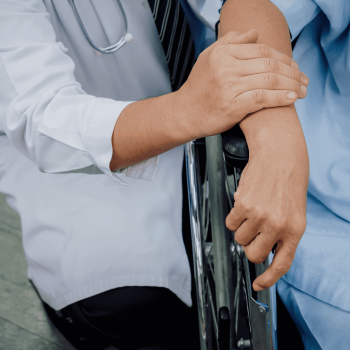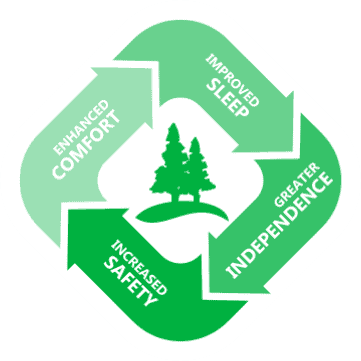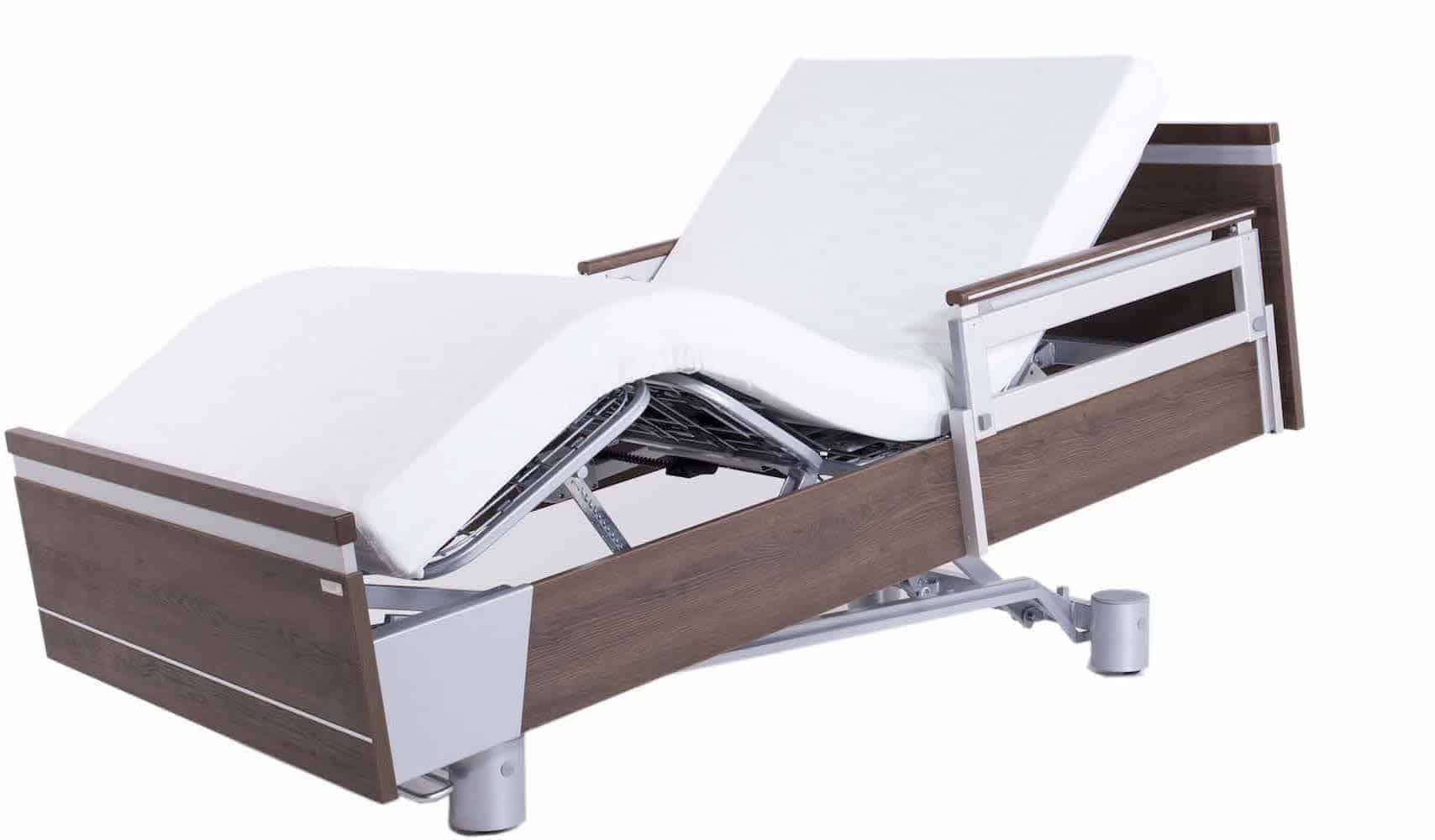Learn About How A Hospital Bed Improves Comfort and Independence for those with Muscular Dystrophy
What Is Muscular Dystrophy? A Quick Intro
Understanding muscular dystrophy requires knowing how muscles work. Muscles consist of fibers that are essentially cells encased in an outer membrane. The membrane is made of a group of proteins known as the “dystrophin-glycoprotein complex,” which stops damage from occurring when muscles relax and contract.
Muscular dystrophy affects the protective membrane; when the sheath is damaged, the muscle fibers leak creatine kinase, a protein necessary for chemical reactions producing energy for muscle contractions. They also take on excess calcium, causing further weaknesses. The degeneration of the fibers affects the patient’s voluntary movement and range of motion; eventually, the muscle will die from the damage.
Muscular dystrophy isn’t one disorder; it’s a group of roughly 30 neuromuscular diseases, all with unique symptoms. These disorders can vary based on age, severity, and pattern; some affect specific body parts and systems, such as the heart, respiratory muscles, gastrointestinal system, endocrine glands, and spine. These conditions all have one thing in common: they are progressive diseases with a loss of muscle mass.
As the muscles deteriorate, many individuals contract respiratory and cardiac diseases, develop issues with swallowing, and lose their ability to walk. All forms of muscular dystrophy are genetic, and contemporary medicine cannot prevent its development. However, patients have more tools available than ever to find comfort and mobility support. One of these tools is the hospital bed.
The identification of the protein dystrophin has led to a new understanding of the muscle cell membrane and the proteins involved in membrane stability. Guiraud, S., Aartsma-Rus, A., Vieira, N. M., Davies, K. E., van Ommen, G.-J. B., & Kunkel, L. M. (2015). The pathogenesis and therapy of muscular dystrophies. Annual Review of Genomics and Human Genetics, 16, 281-308. https://doi.org/10.1146/annurev-genom-090314-025003
- Muscular dystrophy is a group of roughly 30 neuromuscular diseases
- Different forms can affect specific body parts and systems
- All forms are genetic and progressive diseases causing loss of muscle mass
- Symptoms vary based on age, severity, and pattern
- Hospital beds can provide support and comfort for patients with muscular dystrophy
Hospital Beds Make Care For Muscular Dystrophy Easier
For patients with muscular dystrophy, being able to adjust and reposition the bed does more than provide comfort. Those with the condition can find muscle spasms, weakness, contractures, and spinal irregularities that force them into uncomfortable positions. Postural correction can counter these side effects and reduce the degree of muscle weakness.
To counteract this, a patient should sit upright with their feet at a 90-degree angle to the floor. An in-home hospital bed can help them take on this position for longer while enjoying the comforts of home. Adjustable head and feet and support aids like the overhead trapeze helper bar can help them maintain mobility while in bed.
- Muscular dystrophy can lead to uncomfortable positions and muscle weakness
- In-home hospital beds with adjustable head and feet can help with postural correction
- Support aids like the overhead trapeze helper bar maintain mobility
Hospital Bed Mattresses Also Provide The Right Amount Of Support
Hospital beds have special mattresses that contour to the patient’s preferred bedframe adjustments, but it also has to provide support. When progressive muscle degeneration makes it too difficult to move, the patient can’t sink into their mattress, as they might not have the strength to pull themselves out. Conventional memory foam mattresses do not provide the support necessary, and many people with muscular dystrophy struggle with them in a quest for comfort.
SonderCare mattresses use a Memory Foam top layer that provides top-level comfort and pressure redistribution. The foam is injected with a cooling gel to help regulate body temperature while on the mattress, and the pressure redistribution reduces the likelihood of bed sores. However, this two-inch layer sits on a foundation that offers strength and durability, while the firm perimeter edge provides support as the patient transfers into and out of bed.
Hospital Beds Are Ideal For Comfort and Independence for Muscular Dystrophy (MD)
Many people with muscular dystrophy should choose a hospital bed because it affords a higher degree of comfort than conventional beds. A good night’s sleep is essential for everyone, but for people living with neuromuscular diseases like muscular dystrophy, it can be vital for handling their condition. However, physical symptoms and a high degree of muscle weakness can prevent getting restful sleep, and the older one is, the harder it can be. Being able to reposition during the night can minimize side effects, such as swelling associated with muscle weakness and inactivity.
Hospital beds let the patient reposition themselves more easily. The user can shift their weight by raising or lowering the head and foot of the bed with the hand controller or accessories like the overhead trapeze helper bar. The high-low elevation also lets caregivers raise the bed to their hip level, eliminating the need for stooping and bending and reducing the risk of stains and stress injuries.
One issue many people struggle to overcome is the loss of their former identity. They slowly lose the ability to act independently, have to undergo constant medical care, and need to add a whole host of assistive equipment to their home. It can be essential that their new supporting equipment – including their care bed – doesn’t look like something out of a hospital.
SonderCare is changing what beds can mean for muscular dystrophy patients across North America. Our premium hospital beds provide all the essential features one needs for mobility, stability, and comfort. These features come wrapped in beautiful materials that look and feel like regular beds. If you’re shopping for a loved one, a SonderCare luxury hospital bed can help them feel more at home while they get the assistance they need for their condition.
Disability in Duchenne muscular dystrophy can be minimized by the use of properly fitting and functioning equipment. Stuberg, W. (2006). Home accessibility and adaptive equipment in Duchenne muscular dystrophy: A case report. Pediatric Physical Therapy, 18(3), 215-220. https://doi.org/10.1097/01.pep.0000224127.40004.88
- Hospital beds provide more comfort for people with muscular dystrophy
- They allow for easy repositioning to reduce swelling and injuries
- SonderCare luxury hospital beds offer essential features in a beautiful design
From Our Experience... "Muscular dystrophies have harsh effects on mobility for people young and old and I've seen it first hand. If you can get quality medical equipment to improve your daily functioning then it is highly recommended. SonderCare can help with a certified hospital bed but there are many other products ranging from wheelchairs to walkers that are known to have a positive impact as well."
Kyle Sobko Hospital Bed Expert
- Muscular dystrophy is a group of genetic neuromuscular diseases that cause muscle weakness and degeneration.
- Hospital beds can help with postural correction and reducing muscle weakness in patients with muscular dystrophy.
- Hospital bed mattresses provide the necessary support for patients with progressive muscle degeneration.
- Hospital beds afford a higher degree of comfort than conventional beds for people living with neuromuscular diseases.
- Hospital beds allow patients to easily reposition themselves, which can minimize side effects and reduce the risk of stains and stress injuries.
- SonderCare luxury hospital beds provide mobility, stability, and comfort while looking and feeling like regular beds.
Frequently Asked Questions About Muscular Dystrophies Therapy
Muscular dystrophy is a group of genetic disorders that cause progressive muscle weakness and wasting. Hospital beds can help people with muscular dystrophy by providing them with a comfortable and supportive surface to rest and sleep on, as well as features that can help with mobility and safety.
Hospital beds can be adjusted to different heights to make it easier for people with muscular dystrophy to get in and out of bed. They also come with side rails that can be raised to help patients move in and out of bed more easily and safely. Additionally, some hospital beds have built-in lifts that can assist with transferring patients from the bed to a wheelchair or other mobility device.
Yes, hospital beds can be equipped with features that can help people with muscular dystrophy breathe more easily. For example, some hospital beds can be adjusted to an inclined position, which can help reduce airway obstruction and improve breathing. They can also be equipped with respiratory support devices, such as CPAP machines or ventilators, if needed.
Hospital beds can help prevent complications such as pressure ulcers in people with muscular dystrophy. The beds come with specialized mattresses and pressure-relieving surfaces that distribute weight evenly and reduce pressure on vulnerable areas of the body, such as the hips, back, and heels.
Hospital beds are designed with various safety features that can help prevent falls and other accidents in people with muscular dystrophy. For example, the beds can be adjusted to different positions to reduce the risk of patients falling out of bed. They also come with side rails and bed alarms that alert healthcare providers if a patient attempts to get out of bed unassisted.
Choosing the right hospital bed for people with muscular dystrophy depends on several factors, including the patient’s mobility level, weight, and height, as well as their specific medical needs. It’s essential to work with a healthcare provider or medical equipment supplier to select the appropriate bed and ensure that it meets the patient’s needs.














